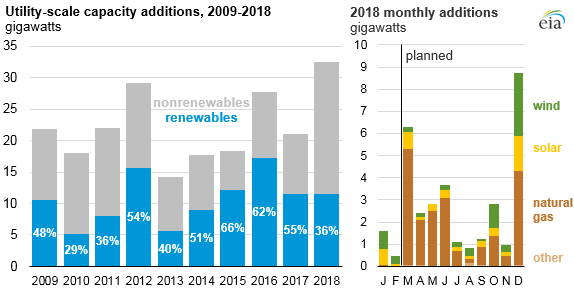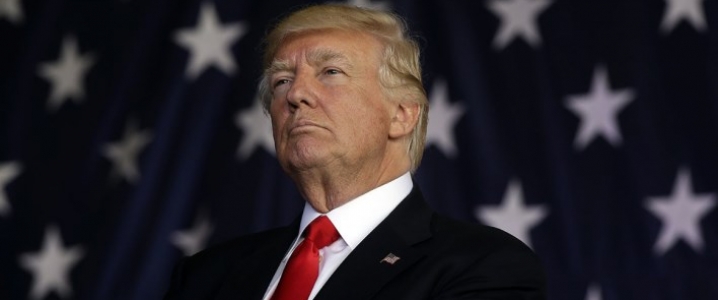Oil markets saw extreme volatility on Tuesday, with prices originally crashing on rumors that the Iran deal would remain in place before Trump tore it up.

(Click to enlarge)

(Click to enlarge)

(Click to enlarge)

(Click to enlarge)
- The EIA expects nearly 32 gigawatts (GW) of new electricity capacity to come online this year, the largest single-year capacity growth in over a decade.
- To date, wind and solar accounted for 98 percent, or 2 GW, of the capacity additions so far.
- But, the EIA sees 21 GW of new natural gas before the end of 2018, which will mark the first year since 2013 that renewables didn’t make up more than 50 percent of new capacity.
Market Movers
• Royal Dutch Shell (NYSE: RDS.A) announced plans to sell its 8 percent stake in Canadian Natural Resources (NYSE: CNQ) for about $4.3 billion.
• Carrizo Oil & Gas (NASDAQ: CRZO) saw its share price jump more than 5 percent in after-hours after reporting strong Q1 numbers. Production was up 11 percent year-on-year.
• BP (NYSE: BP) signed a deal with Iraq’s North Oil Company to triple production at six oilfields in the Kirkuk region, which would push output above 1 million barrels per day. The oil fields were previously under the control of Kurdistan, but the Iraqi government forced them out last year.
Tuesday May 8, 2018
On Monday, oil prices jumped to their highest level since late 2014, with WTI jumping above $70 per barrel for the first time in years. Oil gave up some of those gains on Tuesday morning as various media outlets confused the markets with contradictory statements, but as soon as the press conference started, prices started to recover as President Trump announced the end of the nuclear deal and promised to re-impose economic sanctions against the Islamic Republic of Iran.
Trump tears apart Iran deal - announces economic sanctions. President Trump said he would announce his decision on the Iran nuclear deal today at 2 pm ET. Oil prices fluctuated in anticipation of President Trump's speech and were down about 2.5% before the broadcast. President Trump mentioned in the conference that his country will re-impose economic sanctions of the ''highest level'' and that they will be instituted in the next couple of months. Analyst estimates vary on the implications, ranging from zero impact to knocking as much as 800,000 bpd offline. French oil giant Total SA (NYSE: TOT), one of the few western companies with big plans for Iran, is hoping that U.S. action won’t derail its $1 billion deal to help develop the South Pars gas field. "The geopolitical consequences of a possible dismantling of the JCPOA would likely to play a larger and long-lasting role in pushing oil prices higher than short-term policy uncertainty," Michael Cohen, Barclays director of energy market research, said in a research note Monday. Related: Saudi Arabia's Needs Have Become Iran's Problems
OPEC oil production fell for third straight month. OPEC production dipped in April yet again, falling to a one-year low. According to S&P Global Platts, output fell to 32.0 million barrels per day (mb/d), a decline of 140,000 bpd from March, and crucially, 730,000 bpd below the group’s stated target. The over-compliance is the result of a rapid and ongoing deterioration in Venezuela’s production, plus Iraq’s output dipped for the first time in months.
Energy stocks no longer out of favor. The energy portion of the S&P 500 significantly trailed the broader S&P 500 over the past year, despite the more than 50 percent gain in oil prices. However, energy stocks are finally coming back into fashion, with WTI now at a three-year high. Since April, the energy sector has outperformed the S&P 500, rising by 10 percent. Energy is now the second-best performing sector in 2018, after claiming the worst spot last year. The WSJ notes that Valero (NYSE: VLO), Anadarko (NYSE: APC) and Hess Corp. (NYSE: HES) have all gained more than 20 percent this year. Taken together, the energy sector within the S&P 500 are expected to report collective earnings gains of about 93 percent.
China’s oil imports hit record high. China’s crude oil imports hit a record high in April at 9.64 mb/d, a jump of 14.7 percent year-on-year. The previous record high was 9.61 mb/d in January, according to S&P Global Platts.
ConocoPhillips claims PDVSA assets in Caribbean. Attempting to enforce an international arbitration award, ConocoPhillips (NYSE: COP) moved to take over assets from PDVSA on several Caribbean islands. The move could be catastrophic for Venezuela. According to Argus Media, PDVSA has begun recalling its oil tankers from Dutch Caribbean waters in order to avoid further asset seizures, which will mean it also cannot import fuel and diluent that it needs. Crude oil exports also could be curtailed as a result, and based on the recall of oil tankers, the effects could be immediate.
Saudi Arabia says inventory five-year average not the right metric. Saudi oil minister Khalid al-Falih explicitly ruled out the five-year average as the proper metric to evaluate the health of the oil market. He said on Monday that the five-year average is inflated by the surplus years. The market has made progress but “we certainly don’t feel we are where we need to be,” Al-Falih said. “We believe we are on our way to restoring energy stability to the markets.” Al-Falih added that OPEC and its non-OPEC partners will discuss targets and metrics next month in Vienna at their official meeting. Meanwhile, Iranian officials have come out against higher oil prices, suggesting $60 to $65 would be appropriate.
Natural gas production soaring. U.S. natural gas production is rising so quickly that inventories are rapidly building up. Stocks had dipped on strong demand this winter, but are now rising quickly on huge production gains and mild spring temperatures. “The make-or-break point in the market is going to occur within the next two reports,” Stephen Schork, president of Schork Group, told Bloomberg. If inventory gains are “super high, I won’t be long gas.” He added that strong output gains could push natural gas prices down to $2.25/MMBtu.
Related: The Future Of U.S. Oil Relies On A Single Play
Wall Street analysts wrong on oil prices. The Wall Street Journal noted that analysts from more than a dozen major investment banks predicted that Brent crude would average $57 per barrel in the first quarter, when in reality Brent averaged $67 per barrel. “Predicting oil prices is a mug’s game,” Craig Pirrong, a professor of finance at the University of Houston, told the WSJ. “The inelasticity of supply and demand mean that the price is very sensitive to random shocks that are themselves hard to predict.”
EU considers emissions targets for trucks. France and four other EU countries are pushing for CO2 limits on heavy trucks. France wants “ambitious objectives to be fixed for 2025, 2030 and 2050 in order to expand efforts to decarbonise transport,” according to a position paper seen by Reuters. A separate paper from Ireland, Lithuania, the Netherlands and Luxembourg support CO2 emissions reductions of 24 percent for 2025. The European Commission is expected to propose the EU’s first-ever limits for trucks on May 16. Trucks only account for 5 percent of the vehicles on the road but makeup about a quarter of transit related emissions.
By Tom Kool for Oilprice.com
More Top Reads From Oilprice.com:
- Oil Crashes Ahead Of Trump’s Iran Deal Decision
- Why Oil Prices Are Likely To Go Higher
- Qatar Petroleum To Boost Production Despite Blockade



















Is it intentional or politically motivated towards Europe? That's a question not completely irrational either.
When we hear "The US slapped sanctions on Iran" we read "The US slapped on sanctions on Europe on the pain of the bankrupting any entity in Europe that dares to invest in or trade with or buy oil from Iran"
One may wonder when Europe gets really tired of this "economic bullying" and abuse of the dollar-based unique position emanating from its "friend"